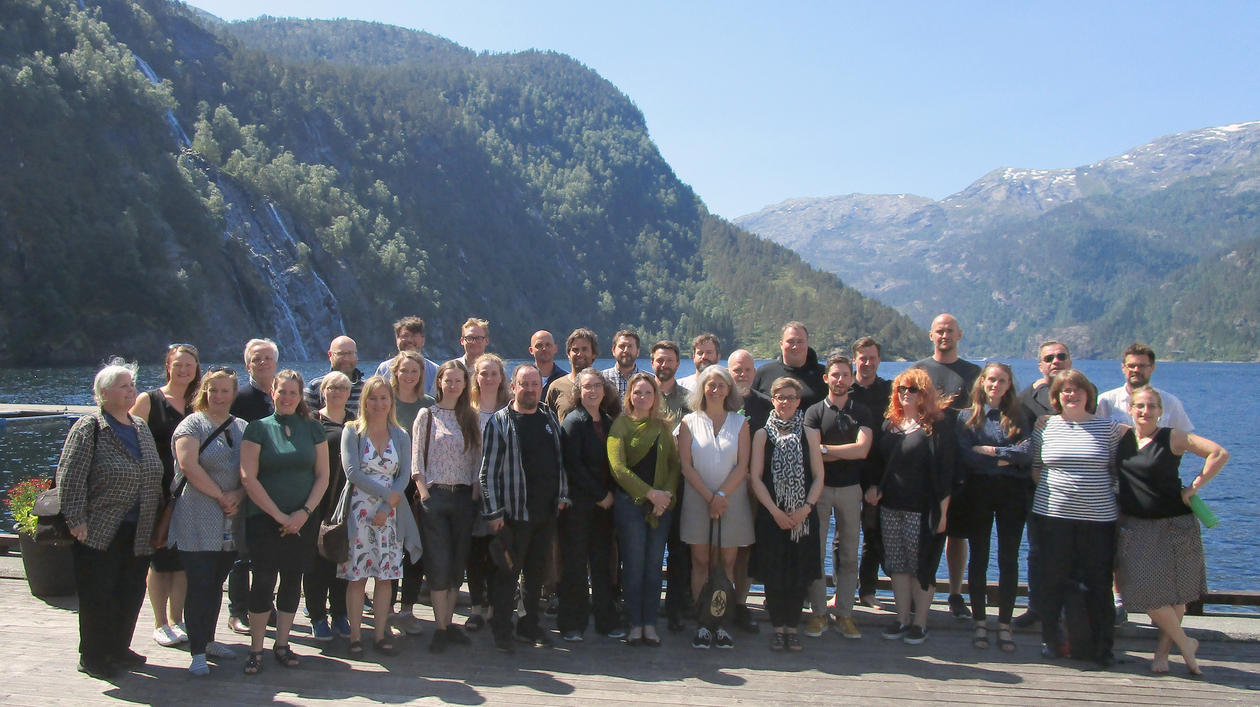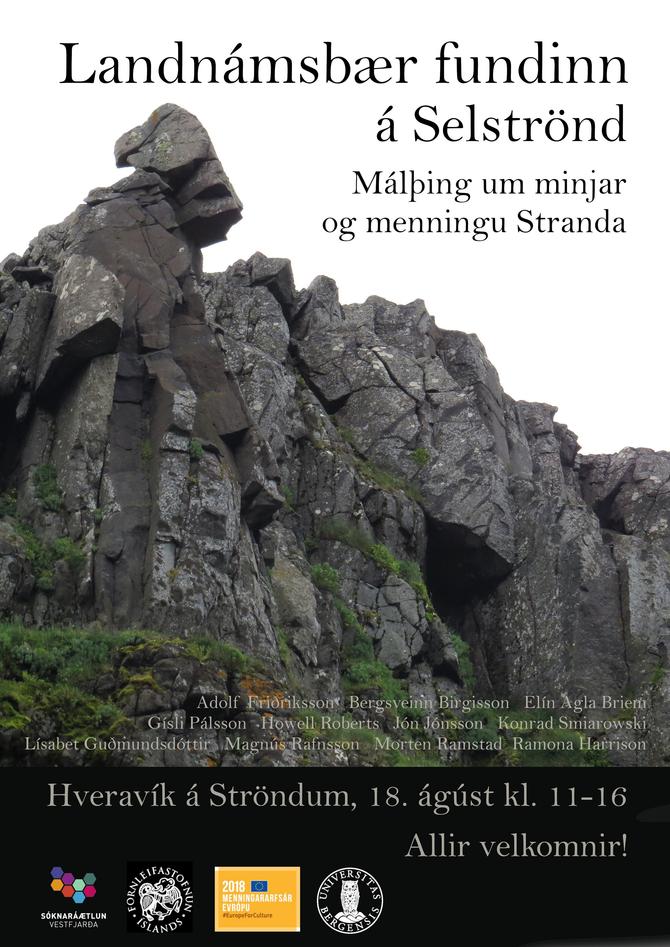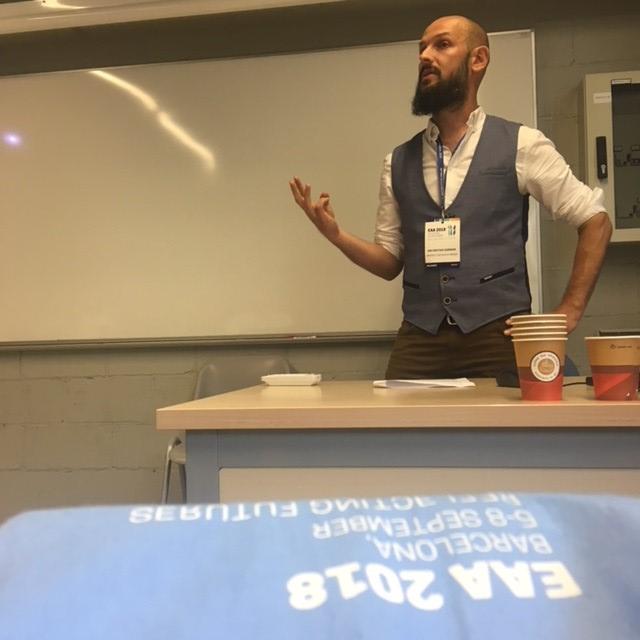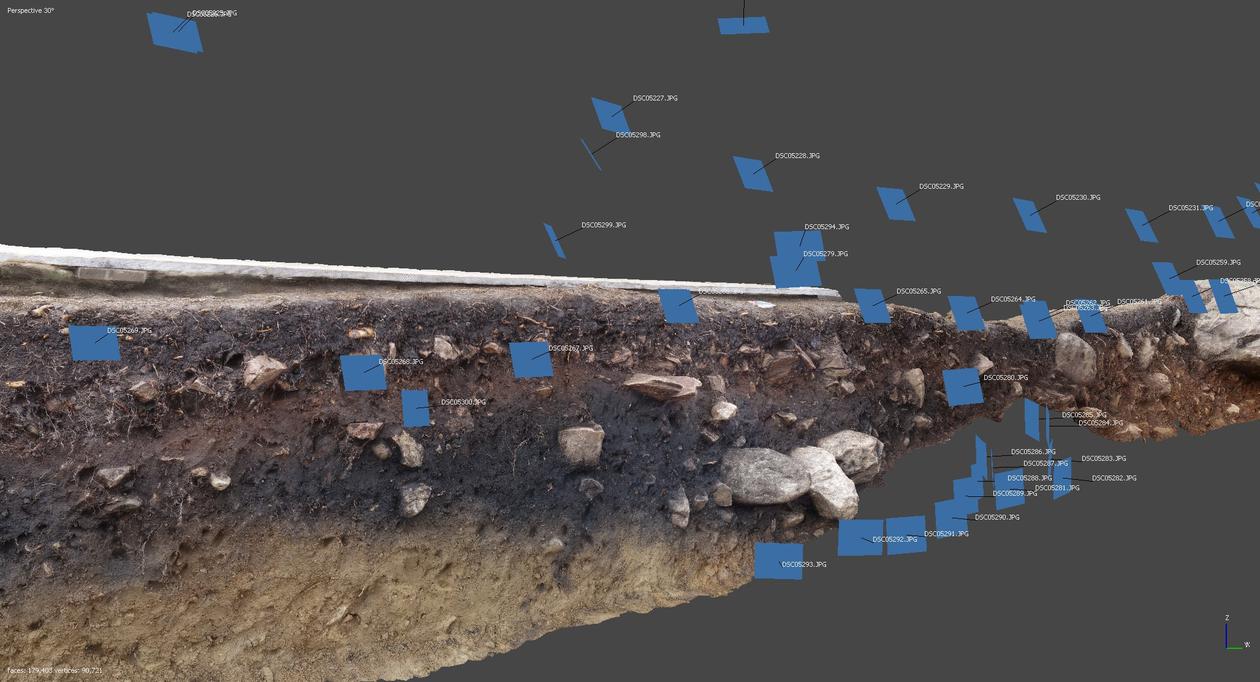Aktiviteter
Main content
Stone Age Transformations
Stone Age Transformations in Coastal Western Norway – an Archaeological-Palynological Approach
Hovedsiktemålet i prosjektet er å undersøke demografiske endringer blant jeger-sankere og tidlige jordbrukere i tempererte kystsoner i løpet av tidlig Holocen tid, og å bruke Vestlandet som en case. Underordnede siktemål er (1) å kalkulere langtids endringer i distribusjonene av C14-dateringer, løsfunn, boplasser og pollenbasert vegetasjonsdekke, og å bruke disse som proxies til studiet av demografisk endring, (2) å utvikle en diakron modell for forholdet mellom landskapssoner, vegetasjonsdekke og relative befolkningsmengder, og (3) å syntetisere de komplette arkeologiske og palynologiske datasettene for å gi et interdisiplinært metodologisk bidrag til den internasjonale debatten om steinalderen demografi.
Prosjektet er initiert av Knut Andreas Bergsvik og botaniker Kari Loe Hjelle, og bergensgruppen består av arkeologene Leif Inge Åstveit, David Neill Simpson og Kim Darmark fra Universitetsmuseet, og Jostein Aksdal fra Hordaland/Vestland fylkeskommune.
En prosjektsøknad er nå til bedømmelse ved FRIPRO programmet ved Norges Forskningsråd.
I løpet av høsten 2019 ansettes det en PhD stipendiat (4 år) knyttet til dette prosjektet. Stipendet finansieres i sin helhet av Universitetsmuseet i Bergen.
Borgundkaupang-prosjektet 2018-2023
Av Gitte Hansen, Universitetsmuseet i Bergen
Life and death of a small town in the periphery of medieval Europe
Curation, research and dissemination in progress
During the Middle Ages Borgund was one of Norway’s 14 urban sites. It was located just outside today’s Ålesund at Sunnmøre in western Norway. The kaupang emerged as a thriving community in the late Viking Age but was deserted some 300-500 years later in the late Middle Ages. Little basic research has been carried out on the archaeological collections from Borgund. In The Borgund Kaupang Project the large and diverse data set from the site is re-vitalised.
The Sagas’ Borgund identified: In 1953 the Prestegårdsjordet just outside Ålesund was identified as the site of ‘the small town Borgund’ known from the written sources.
Great interest locally and in Bergen was evoked and under the leadership of Asbjørn E. Herteig from Historisk Museum UIB, today’s University Museum of Bergen, archaeological field campaigns were conducted from 1954 and on. Through all in all 20 field seasons c. 5300 m2 have been investigated and represent the most extensive medieval excavations in Norway outside the large towns.
With good preservation conditions for all kinds of materials 45.000 artefacts of leather, bone, wood, metals, ceramics and stone and a similar amount of zoo-archaeological material are available for research… BUT basic site analyses (dates, stratigraphy) as well as artefact and archive curation are called for to unleash the full potential of the archaeological sources.
The Borgund Kaupang Project studies life and death of the small town. We ask
*Did a vulnerable mono-economy prevail in Borgund?
*How and to what degree did institutions and inhabitants of Borgund participate in local, national and international economic, cultural and social networks?
Our hypotheses are
* That, Borgund, as one of Norway’s small towns, had a central role in processing and refining natural resources from sea and land. It also served as a regional hub for outfield produce aimed at trade with Europe and the North Atlantic region. As such the survival of the small town was sensitive to changes in the exploitation and redistribution systems related to natural resources.
* That, the inhabitants of Borgund, during the successful centuries, were part of international economic, cultural and social networks and enjoyed a life style with influence from distant parts of Europe and the North Atlantic region.
Organisation
The project is directed and co-ordinated by the University Museum of Bergen Dep. Of Cultural History with Prof. Dr. Gitte Hansen as PI. Associates in the project are researchers, crafts-people and disseminators from the museum sector and research institutions in Norway, USA, Germany and Belgium, as well as from the faculty of humanities of UIB.
The project comprises a number of part-studies and collaborates with other projects of which some have started, while others will begin in 2019. Partners have so far pitched in with their own funding. External funding – fresh money – is, however, needed for the full potential to be taken out. Such funding is currently applied for.
On-going studies:
Borgund’s role in North Atlantic networks, and the Borgund townspeople’s social standing: Imported textiles at Borgund: Michèle Hayeur Smith, Brown University USA. Archaeological bird remains from Norway as a means to identify long-term patterns in a Northern European avifauna: Samuel J.Walker, UM-Dep. Nat. Hist./UIB. Weaving the Vikings’ life ensurance: Monica Ravnanger & Marta Kløve Juul, Museumssenteret i Hordaland. Species identification of Leather used in Viking Age shoes at the Borgund Kaupang. Heidi A. Haugene, Sunnmøre Museum. Borgund’s production and consumption of hair combs in a North European context: Gitte Hansen, UM-Dep. Cult. Hist./UIB
COASTARK på EAA Barcelona 2018
5.-8. september 2018 ble den årlige internasjonale konferansen European Association of Archaeologists (EAA) arrangert. Flere prosjekter tilknyttet COASTARK ble presentert gjennom foredrag.
Rockshelters in western Norway. Suitable dwelling places for 11th-17th century (AD) folks?
Knut Andreas Bergsvik, Gitte Hansen
Sesjon "Meaningful places: integrating theories, methods and scientific techniques in the archaeological study of a dwelling place"
Rockshelters are numerous in the rocky and mountainous landscapes of Norway. The shelters are created as a result of geological processes such as erosion in geological fault-zones or because of rock-fall. There are also large numbers of boulder rockshelters with enough space underneath for human occupation. Rockshelters were used extensively as dwelling places in Norway during prehistory, and less extensively during the Middle Ages. In medieval written sources and later folklore rockshelters have negative and even scary connotations, and based on literary sources some researchers have related the places to poor people. But how were the shelters used according to the archaeological data? In this paper we address the use of 11th-17th century rockshelters as dwelling places in western Norway in coastal areas as well as in the fjords and in the mountains. Data from the medieval and early modern shelters has been collected through cross-disciplinary field work, and the study of archives and museum collections. To what extent were the shelters used as dwellings? What kind accommodation are we talking about? Were the places reshaped and modified to accommodate people in a suitable way? Who were the shelter users in terms of social identity, and what did they do here?
Between the currents. Maintaining Mesolithic ways of life in Neolithic Western Norway
Kim Darmark, Fredrik Solli, Christine Tøssebro, Leif Inge Åstveit
Sesjon "Beyond the farmlands: wild resources in the past of Central and Northern Europe"
The Norwegian west coast is an archipelago that has attracted people throughout prehistory. Stone Age settlements in the region have a tendency to cluster around narrow streams, which are particularly rich in marine food resources. Domesticates do not seem to contribute substantially to the economy until the very end of the Stone Age. Changes in the material culture, however, indicate cultural contacts with agricultural societies.
Ongoing excavations of multiphase sites located on the Sotra islands in the outer coast, west of the city of Bergen, cover the span from the Early Mesolithic up to the Late Neolithic. These clearly illustrate a continued heavy reliance on fishing, fowling and hunting of marine mammals in the region. The thick cultural layers contain large amounts of finds, primarily lithic debris and tools, but also faunal remains. Pottery appears in the later stages. The finds and features uncovered give testimony to a periodically very intensive exploitation of the marine environment, and are presented against a backdrop of earlier knowledge. However, the new data also indicates periods of less activity and settlement breaks of hundreds of years, which give reason to challenge prevalent notions of a steady and gradual growth in sedentism and territoriality on the northern fringes of early European agriculture.
The Mediterranean in 11th-13th century Norway
Gitte Hansen
Sesjon "The Mediterranean in the North: the materual evidence of distant contacts, AD 1000-1800
The paper aims to contribute to the discussion of exotic ‘Mediterranean’ finds from 11th-16th century Norway to give a first insight into such – poorly published - materials across the North Atlantic and Baltic Seas. The first part of the paper gives a summary overview of finds from high- and late medieval Bergen (14th-16th centuries) in the University Museum of Bergen’s collections. The last part of the paper focuses on finds from early medieval (11th-13th century) Norway. The empirical basis is archaeological collections from Bergen and Borgund in Norway, as well as published materials from, especially Norwegian, but also British and Baltic towns. The overview of material culture shows that during the 11th – 13th centuries direct or indirect contact between Norway/the North and the Mediterranean area is reflected in silk yarn used for embroidery on leather shoes, and to a very small degree objects with runic inscriptions and ecclesiastic/exclusive silk textiles. The paper discusses how the exotic Mediterranean finds ended up in the North.
Adaptive Photogrammetry: the use of photogrammetry within the excavation environment of infrastructural archaeology
Justin Kimball, Leif Inge Åstveit
Sesjon "Examining the different approaches, theories, and methodology both culturally and in the application of European Commercial Field Archaeology"
Photogrammetry is becoming a standard tool within archaeology, yet there remains uncertainty to its definitive role. Important questions remain, the most notable being “how can photogrammetry benefit archaeological documentation?” and “when is it appropriate to use photogrammetry?”. We must be willing to answer questions like these in order for archaeology to incorporate and benefit from new technologies. This is an active issue within research archaeology; however, the goals of research archaeology do not necessarily match those within archaeology as a whole. Today, infrastructural archaeology, not research archaeology, accounts for the majority of excavations and it is within this that we must explore the role of new technologies. We have endeavoured to address this issue within the Sotrasambandet project—a large infrastructural archaeology project managed by the University of Bergen. The project involves the excavation of several Stone Age sites situated on the western coast of Norway ahead of the construction of a new roadway. These kinds of projects are fast-paced and highly dynamic, and archaeologists working in these environments must have access to the right tools and methodologies to perform their jobs. At the Sotrasambandet project, we have found that photogrammetry is a powerful component of our documentation strategy. Through this technology, we have been able to achieve both traditional and novel formats of documentation for infrastructural archaeology. Most significant, has been that using this technology has allowed us to achieve an adaptive photogrammetry—in other words, we have established a methodology that allows archaeologists to document in 3D and return that data quickly to the field in a variety of formats for immediate use. Our use of photogrammetry addresses the issues highlighted above by developing a framework for the technology while demonstrating its ability to affect the quality and functionality of documentation within the constraints of infrastructural archaeology.
The conumption of everyday objects in rural western Norway, c. AD 1100-1350
Therese Nesset
Sesjon "The value of objects in medieval rural settlement"
Research on medieval artifacts in Norway has, as in other parts of Europe, focused on urban areas, on mass-production of objects in outland areas, national and international trade, and studies of large corpuses of the same type of objects (primarily found in urban areas). The knowledge about rural households in early medieval Norway is mostly based on later written sources and social conditions, and much less on contemporary archaeological sources from “normal” rural households. This paper will be based on my PhD-project, which is in its final stages. The project’s main research questions concern everyday life of ordinary people in rural western Norway, with a social bottom-up-perspective. The source material is from five archaeologically excavated (single) farms, focusing on the period c. AD 800-1350. The farms have different topographic and geographic conditions; belong to different social strata of society; and range geographically from central to peripheral (by present day standards). Traditionally, medieval peasants in Norway have been regarded as fairly self-sufficient, and have rarely been studied as consumers of goods or as part of a wider economic networks or trade. Especially because of the rugged terrain of western Norway, people living in rural areas have been seen as quite isolated from society at large; the growing urban centers and the elite. This paper will focus on the peasants as consumers of goods, and will present the objects found within, or connected to, the house remains at the farms. The focus of the paper will be on the period from the late 1100s to c. 1350. By looking closer at what people actually owned, I will discuss the value of the everyday objects from the different households; the provenance of the objects and raw materials is addressed: were they home-made/local or from trade?; also life-style is addressed: did people prefer a traditional rural life style or can we trace new cultural (and maybe urban) impulses, and if so: where?
Understanding et-Tell as heritage in a past and present urban landscape
Hamed Salem (Birzeit University, Palestine), Nils Anfinset
Sesjon "For future reference: understanding the city, (re)presentations of the urban landscape and the past-as-present"
In the Early Bronze Age the urban centre Tell et-Tell was one of several urban centres in the southern Levant as part of the rapid urban development in the Near East in general. Three millennia later the first excavations took place at Tell et-Tell from 1928-until the present through different aims, perspectives and methodologies. We will start to draw some lines from the earliest excavations and interpretations of the site, and look at how earlier researchers have placed the site within the urban landscape, both in the past and in its present excavation context. Thereafter we try to situate ourself within the present context of an extreme rapid urbanization, and to a large degree an over-urbanization which is out of hand where the overall heritage often is neglected and destroyed. This paper builds on recent fieldwork and studies of et-Tell as an urban site and its present adjacent village. But how are we to understand this city, as part of an ever-increasing urban landscape of Palestine? How is the urban landscape connected to the changing political landscape? How is the past of this specific urban center presented over the last 100 years, and how is this communicated and part of the social memory of people living in the vicinity and the more general opinion of the site.
Sandvík, Strandasýsla på Island. Migrasjon og landnåm og maritime relasjonar i vikingtid
Av Morten Ramstad, Universitetsmuseet i Bergen
«Sandvík, Strandasýsla på Island. Migrasjon og landnåm og maritime relasjonar i vikingtid» er eit samarbeidsprosjekt mellom Universitet i Bergen, Institute of Archaeology of Iceland og forfattar og filolog Bergsvein Birgisson.
Prosjektet er knytta til “European Year of Culture Heritage 2018; Our heritage - where the past meets the future” og inneheld to modular. Modul 1 er eit pilotprosjekt med utgangspunkt i arkeologiske granskingar av vikingtidsbuplassen Sandvík, Strandir, Vestfjordane på Island i august 2018. Lokaliteten representerer ein kystorientert buplass frå landnåmsfasen. Her er eit variert beinmateriale som vitnar om betydinga av marine ressursar som fisk, sel, kvalross og fugl. Kunnskapen om vikingtidsgardar på Island kjem primært frå gardar orientert mot husdyrhald og noko dyrking medan det er undersøkt svært få lokalitetar med ein klar maritim orientering. Sjølv om det er kjent fleire kystnære gardar frå vikingtida i Noreg har det i nyare tid ikkje vore utført faglege granskingar av desse. Paradoksalt nok, har me difor frå desse to nært forbundne kystnasjonane svært liten kunnskap om betydinga av marinfangst og fiske i vikingtid. Det er venta at utgravingane vil bidra med eit viktig materiale som vil gje eit breiare og meir nyansert bilete av det maritime livet i landnåmstida.
Undersøkingane er eit pilotprosjekt planlagt som ein del av ei større utforsking av det maritime livet, og dei kulturhistoriske banda mellom Island og Noreg, i vikingtida. Prøveundersøkingar fann stad i august 2018. Nå er me i etterarbeidsfasen, med funnbehandling, analyse, digitalisering og rapportskriving. Sidan tefralag (fortidige oskelag etter vulkanske aktivitet) manglar i denne delen av Island er me avhengig av C14 dateringar for meir nøyaktig tidfesting av funna. Me ventar difor i stor spenning på resultant frå desse.
Modul 2 knyter seg til av eit seminar som vart halden på Island, 18. august med foredrag frå prosjektgruppa og andre inviterte fagfolk, http://www.minjastofnun.is/media/skjol-i-grein/fornleifar-a-stondum.pdf . I tillegg var det open dag i felt, med over 100 vitjarar. Utgravinga fekk og stor merksemd i media, inkludert sendingar i nasjonal radio- og tv, sjå: http://www.ruv.is/spila/klippa/landnamsbaer-a-strondum
Prosjektet er støtta økonomisk av:
L. Meltzers Høyskolefond
Letterstedska Föreningen
Universitetsmuseet i Bergen
Uppbyggingarsjóður Vestfjarða
Deltakarar og prosjektansvar
Bergsveinn Birgisson, dr.art. i norrøn filologi og forfattar.
Björn Guðni Guðjónsson, arkeologistudent University of Iceland/feltassistent
Gísli Pálsson, PHD student Umeå Universitetet/arkeolog Institute of Archaeology of Iceland.
Howell Roberts, leiar utgravingsseksjonen/arkeolog, Institute of Archaeology of Iceland.
Kathrine Stene forskar/arkeolog Kulturhistorisk museum Oslo, UiO.
Lísabet Guðmundsdóttir PHD student University of Iceland/utgravingsleiar.
Morten Ramstad, forskar/prosjektkoordinator, Universitetsmuseet i Bergen, UiB.
Ramona Harrison, førsteamanuensis/zoo-arkeolog, Institutt for arkeologi, historie, kultur- og religionsvitskap, UiB.
Expanding Horizons
Tekst kommer
Kinnprosjektet
Utgravninger av "Bornihelleren" på Kinn 4. - 7. juni 2018. Målet er å undersøke sammenhengen mellom steinkirken fra middelalder og Bornihelleren som ligger i en skråning ovenfor kirken. Kinn er nevnt i skriftlige middelalderkilder som et kristent kultsted på samme måte som på Selja. På Selja var et en klar sammenheng mellom kirken/klosteret og Sunnivahulen.
https://www.nrk.no/sognogfjordane/forskarar-pa-jakt-etter-ny-kunnskap-pa-kinn-1.14075679







